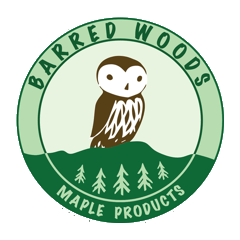Vermont Maple Products
The processes we use to make our Vermont maple cream, maple candy, and maple sugar are all basically the same. We start with pure Vermont maple syrup, usually a lighter grade produced earlier in the season. Maple syrup is about 66-67% sugar and is a thick liquid at room temperature. We take this syrup and boil off additional water to create what is known as a supersaturated solution. These solutions are still liquid at high temperatures, but will solidify at room temperature. We cool the heated mixture and as it cools we churn it to promote crystal growth. It then cools to room temperature and solidifies into the delicious treats we enjoy so much.
The key to making the best tasting maple candy, cream, and sugar is to control the crystal growth. The sugar in maple syrup is mainly sucrose molecules. You can think of these molecules as Lego's building blocks. As you heat maple syrup and remove more water, these Lego's blocks still stay dissolved in the water. But as soon as you start to cool there are too many of these Lego blocks for the amount of water, and they come together. If the Lego blocks come together in a nice organized pattern it becomes a sugar crystal. Your tongue can detect the size of these crystals. To get a nice creamy texture in our maple cream and candy you want many smaller crystals and not fewer larger crystal. You control the number and size of these crystals by the rate you cool your supersaturated solution and how and when you churn it.
Since all of the processes involve boiling water off of maple syrup it's important to carefully control the exact amount of water you're removing. The boiling point of water changes each day based on the atmospheric pressure. We calibrate all our thermometers to this boiling point of water on a daily basis, then boil to a fixed number of degrees over this boiling point of water. The table shows how many degrees over the boiling point we take each of our maple confections.
| Heat to | Cool To | Notes | |
|---|---|---|---|
| Maple Cream | Boiling Point of Water +22oF | 55oF | Rapid Cool Using Ice Bath |
| Maple Candy | Boiling Point of Water +30.5oF | 220oF | Worm Mixer |
| Maple Sugar | Boiling Point of Water +50oF | None | We use a Paddle Mixer |
Maple Cream
As the name implies, maple cream (or maple butter or maple spread as it is also known) is the softest of the three maple confections. As you might guess then, it is not boiled to as high of temperature as maple candy or maple sugar. As the table shows we boil our Vermont maple cream to 22 degrees over the boiling point of water that day.
The sideshow shows the sequence of making the cream. It starts with taking the heated syrup and rapidly chilling it an ice bath. The rapid chill ensures that minimum crystallization occurs on the cool down. Then the cooled mixture is spooned into a machine which uses gear pumps to churn it. It slowly crystalizes into many smaller crystals which results in the fantastic creamy texture we desire. When it is at the right consistency we draw it off into individual jars checking for weight.

Pouring Cooled Syrup into Pan

Syrup Agitated by the Machine

Syrup Starts to Crystalize

Getting Thicker, Almost Cream

Pouring Maple Cream in Jar

Finished Product! Maple Cream From Vermont
Maple Sugar
Maple Sugar is perhaps the easiest of the maple confections to make. Here we boil syrup to 50 degrees above the boiling point of water so that virtually all of the water is taken out. We then take the heated syrup and immediately start cooling and stirring it using a paddle style mixture. It takes about 30 minutes for the mixture to fully crystallize. We then cool the sugar on baking trays, use a food processor to break up the clumps, and finally sift the sugar using a 2mm or 3mm mesh sieve.


Heating the Syrup for Maple Sugar
Churning the Maple Sugar
Maple Sugar Candy
Of all of the confections, maple sugar candy is the hardest to make and takes the most manual labor. The reason is that you're fighting physics. On one hand you want your heated syrup to cool and churn enough that it crystalizes into many small crystals that we talked about above. But at the same time you can't cool or churn it too much that it starts to solidify so that you can't pour it into molds. So it's a balancing act that takes a lot of experience to master and still seems to change
Shop For Maple Sugar Candy
